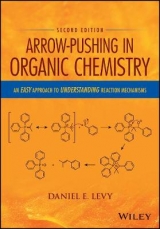
Arrow Pushing in Organic Chemistry
Wiley-Blackwell (Verlag)
978-0-470-17110-3 (ISBN)
- Titel erscheint in neuer Auflage
- Artikel merken
Find an easier way to learn organic chemistry with Arrow-Pushing in Organic Chemistry: An Easy Approach to Understanding Reaction Mechanisms , a book that uses the arrow-pushing strategy to reduce this notoriously challenging topic to the study of interactions between organic acids and bases. Understand the fundamental reaction mechanisms relevant to organic chemistry, beginning with Sn2 reactions and progressing to Sn1 reactions and other reaction types. The problem sets in this book, an excellent supplemental text, emphasize the important aspects of each chapter and will reinforce the key ideas without requiring memorization.
DANIEL E. LEVY, PhD , is the Director of Synthetic Chemistry at Intradigm Corporation, pursuing delivery vehicles for siRNA therapeutics. He previously worked at Glycomed Inc., where he pursued the design and synthesis of novel glycomimetics for the treatment of cancer and inflammatory disorders; COR Therapeutics, where he pursued carbocyclic AMP analogs as inhibitors of type V adenylyl cyclase; and at Scios, Inc., where he pursued novel kinase inhibitors. Dr. Levy coauthored a book entitled The Chemistry of C-Glycosides and later collaborated with Dr. Peter Fugedi in the development and presentation of short courses entitled "Modern Synthetic Carbohydrate Chemistry" and "The Organic Chemistry of Sugars" offered by the American Chemical Society Continuing Education Department. Most recently, Dr. Levy coedited with Dr. Fugedi the book The Organic Chemistry of Sugars, based on the short course of the same name. Dr. Levy received his BS in chemistry from the University of California, Berkeley, and his PhD in organic chemistry from the Massachusetts Institute of Technology.
Preface. Acknowledgments. About the Author . Chapter 1 Introduction. 1.1 Definition of Arrow Pushing. 1.2 Functional Groups. 1.3 Nucleophiles and Leaving Groups. 1.4 Summary. Problems. Chapter 2 Acids. 2.1 What are Acids? 2.2 What is Resonance? 2.3 How is Acidity Measured? 2.4 Relative Acidities. 2.5 Inductive Effects. 2.6 Inductive Effects and Relative Acidities. 2.7 Relative Acidities of Hydrocarbons. 2.8 Summary. Problems. Chapter 3 - Bases and Nucleophiles. 3.1 What are bases? 3.2 What are nucleophiles? 3.3 Leaving Groups. 3.4 Summary. Problems. Chapter 4 - S N 2 Substitution Reactions. 4.1 What is an S N 2 Reaction? 4.2 What are Leaving Groups? 4.3 Where can S N 2 Reactions Occur? 4.4 S N 2' Reactions. 4.5 Summary. Problems. Chapter 5 S N 1 Substitution Reactions. 5.1 What is an S N 1 Reaction? 5.2 How are S N 1 Reactions Initiated? 5.3 The Carbocation. 5.4 Carbocation Rearrangements. 5.5 Summary. Problems. Chapter 6. Elimination Reactions. 6.1 E1 Eliminations. 6.2 E2 Eliminations. 6.3 How do Elimination Reactions Work? 6.4 Summary. Problems. Chapter 7 - Addition Reactions. 7.1 Addition of Halogens to Double Bonds. 7.2 Markovnikov's Rule. 7.3 Additions to Carbonyls. 7.4 Summary. Problems. Chapter 8-Moving Forward 8.1 Functional Group Manipulations. 8.2 Name Reactions. 8.3 Reagents. 8.4 Final Comments. Problems. Appendix 1-pK a Values of Protons Associated with Common Functional Groups. Appendix 2-Answers and Explanations to Problems. Chapter 1 Solutions. Chapter 2 Solutions. Chapter 3 Solutions. Chapter 4 Solutions. Chapter 5 Solutions. Chapter 6 Solutions. Chapter 7 Solutions. Chapter 8 Solutions. Appendix 3-Student Reaction Glossary. Index. Periodic Table of the Elements.
| Erscheint lt. Verlag | 2.9.2008 |
|---|---|
| Zusatzinfo | Illustrations |
| Verlagsort | Hoboken |
| Sprache | englisch |
| Maße | 177 x 251 mm |
| Gewicht | 568 g |
| Einbandart | Paperback |
| Themenwelt | Naturwissenschaften ► Chemie ► Organische Chemie |
| ISBN-10 | 0-470-17110-3 / 0470171103 |
| ISBN-13 | 978-0-470-17110-3 / 9780470171103 |
| Zustand | Neuware |
| Haben Sie eine Frage zum Produkt? |
aus dem Bereich



